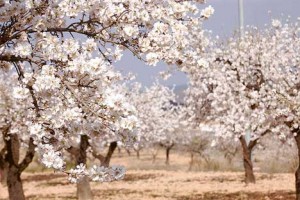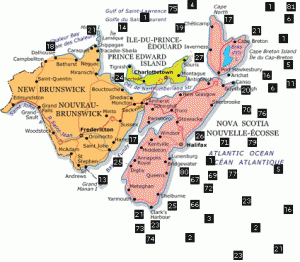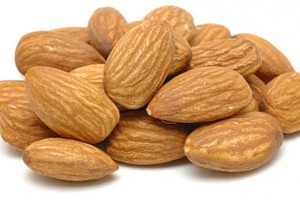It’s lunch time! My plan is to get some healthy fats into my system. I begin with some almonds and smoked salmon. I munch these foods greedily as I begin my studies for the day.
Almonds – 42g portion/ 243 Calories Consumed
Salmon – 45g portion/ 98 Calories Consumed
Beginning with the almonds, I am disappointed to find that my almonds are located in a jar in my cupboard. Therefore, they are not labelled or branded. I ask my wife about them but she cannot remember any details. I guzzle them anyways, like the Big Friend Giant guzzles a snozzcumber. Once again, I will have to speculate about how they arrived in my kitchen.
I’ll assume my almonds came from California because although I know some almonds are grown in the Okanagan Valley, I can’t find much info on Canadian producers. Almonds are grown on trees in beautiful, blooming orchards. 
The almond trees are hardy and don’t need much water, so we’ll consider them mild on the chemical inputs. When harvested, the nut bundles are shaken off of branches by a harvesting machine (oil) and left on the ground. A collector machine (oil) then drives by and scoops them into a collector bin. The nuts are then de-husked using electric machines and some must be manually de-husked. Next, the separated nuts are air-dried.
The almonds are usually processed at a plant very near the orchard. They are transported (oil) to the plant after they’ve dried. Here, they are pasteurized (oil) if they are to be sold in Canada or the USA. The final product is conveyed (oil) into plastic packages (oil), loaded (oil) and transported (big oil) all the way across the country. They arrive at my grocery store and I walked over to greet them.
Now, let’s look at the salmon. It is a brand called Medallion, which I learn is from Prince Edward Island. The company claims, “We smoke it over a smokey fire using our exclusive hand cut local Prince Edward Island hardwoods. We add no sweeteners and, of course, no artificial preservatives.” They don’t offer any more detail, so let’s examine a standard process for catching salmon, preparing it and smoking it.
 The commercial, salmon fishing business is a complicated, political business. Let’s assume that commercial charters net catch the salmon and transport (big oil) them back to shore. From the dock, they’re manually loaded or craned (oil) into refrigerated storage units and transported (oil) to a processing plant. At the plant, the fish are deep frozen and a number of quality tests are performed. Next, comes processing (oil). After processing, the fillets are packaged (oil) and shipped (oil) to a company like Medallion. Medallion claims to smoke the salmon and prepare it the Old Way. The salmon is shrink wrapped and transported (oil) to grocers across Quebec, including my local grocery store.
The commercial, salmon fishing business is a complicated, political business. Let’s assume that commercial charters net catch the salmon and transport (big oil) them back to shore. From the dock, they’re manually loaded or craned (oil) into refrigerated storage units and transported (oil) to a processing plant. At the plant, the fish are deep frozen and a number of quality tests are performed. Next, comes processing (oil). After processing, the fillets are packaged (oil) and shipped (oil) to a company like Medallion. Medallion claims to smoke the salmon and prepare it the Old Way. The salmon is shrink wrapped and transported (oil) to grocers across Quebec, including my local grocery store.


